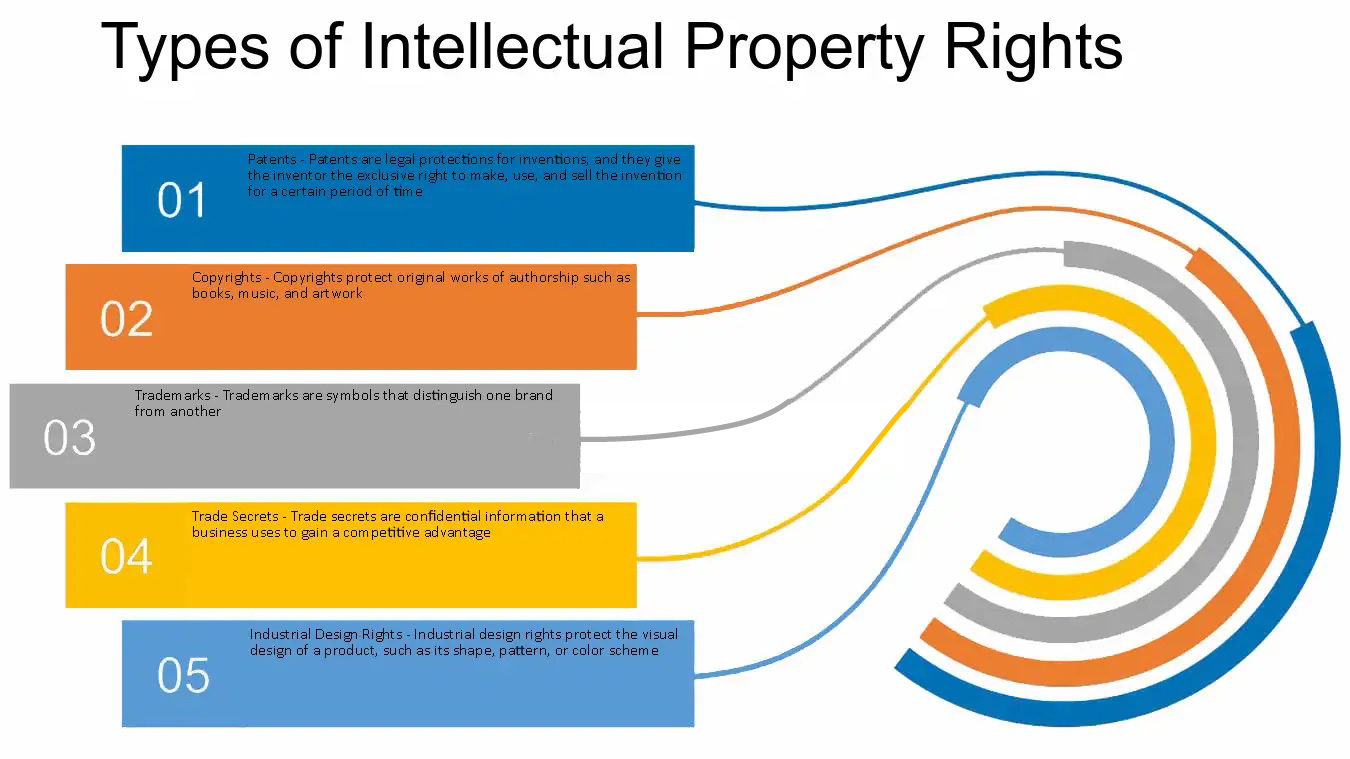What is Intellectual Property
Intellectual property (IP) refers to creations of the mind, such as inventions, literary or artistic works, designs, symbols, or names used in commerce. IP rights grant exclusive rights to creators, protecting their creations from unauthorized use or reproduction.
Navigating the Landscape of Intellectual Property
In the ever-evolving landscape of innovation, the value of Intellectual Property (IP) is immeasurable. Intellectual Property, encompassing patents, trademarks, copyrights, and trade secrets, serves as the guardian of ingenuity, protecting the fruits of human creativity and invention. Let’s embark on a journey through the realm of Intellectual Property, exploring its significance, sample use cases, and real-world case studies that underscore its pivotal role in fostering innovation and safeguarding the rights of creators and innovators.
Decoding Intellectual Property: Guardians of Innovation
What is Intellectual Property?
Intellectual Property refers to creations of the mind, encompassing inventions, literary and artistic works, designs, symbols, names, and images used in commerce. This intangible property is protected through legal mechanisms, encouraging innovation by granting exclusive rights to creators and inventors.
The Significance of Intellectual Property
Incentive for Innovation
Intellectual Property rights serve as a powerful incentive for creators and innovators. By providing exclusivity and the potential for financial gain, IP protections encourage individuals and organizations to invest time and resources in groundbreaking ideas.
Economic Growth and Competitiveness
Nations and businesses with robust Intellectual Property frameworks experience economic growth and enhanced competitiveness. IP fosters an environment where innovation is rewarded, attracting investment, and driving technological advancements.
Cultural and Artistic Preservation
Copyrights and trademarks play a crucial role in preserving cultural and artistic expressions. IP protections ensure that creators maintain control over how their works are used and distributed, preserving the integrity of cultural heritage.
Technological Advancements
Patents play a pivotal role in advancing technology by protecting novel inventions. The exclusivity granted by patents encourages inventors to disclose their discoveries, contributing to the overall pool of knowledge and driving further innovation.
Nurturing Innovation with Intellectual Property – Sample Use Cases
Pharmaceutical Innovations:
- Challenge: A pharmaceutical company invests heavily in research to develop a groundbreaking medication.
- Solution: The company secures a patent for the innovative drug, granting exclusive rights to manufacture and sell the medication for a specified period.
- Outcome: The exclusivity incentivizes the company to invest in research, ensuring a return on investment and driving advancements in medical science.
Tech Gadgets and Designs:
- Challenge: A tech company invests in designing a cutting-edge electronic device.
- Solution: The company obtains design patents to protect the unique visual aspects of the device and utility patents for its innovative features.
- Outcome: The IP protections prevent competitors from replicating the design, fostering a competitive edge and encouraging continued innovation in the tech sector.
Brand Protection in Fashion:
- Challenge: A fashion designer creates a distinctive logo and brand identity for a new clothing line.
- Solution: The designer registers trademarks for the logo, brand name, and other distinctive elements associated with the clothing line.
- Outcome: The trademarks protect the brand from counterfeiting, ensuring that consumers associate the unique design elements with the authentic fashion line.
Software and Copyright Protection:
- Challenge: A software development company invests in creating a sophisticated computer program.
- Solution: The company secures copyright protection for the software’s source code, preventing unauthorized reproduction or distribution.
- Outcome: Copyright protection safeguards the company’s investment in software development, encouraging ongoing innovation and protecting against piracy.
Case Studies: Intellectual Property in Action
Apple’s Patent Portfolio
- Challenge: Apple aimed to protect its innovative products, including the iPhone and iPad, from imitation.
- Solution: Apple invested heavily in securing patents for the design, functionality, and user interface of its devices.
- Result: Apple’s extensive patent portfolio acted as a deterrent against copycats, allowing the company to maintain its position as a leader in the tech industry.
Coca-Cola’s Trademark Legacy
- Challenge: Coca-Cola sought to protect its iconic brand identity, including its logo and distinctive red color.
- Solution: Coca-Cola registered trademarks for its logo, brand name, and the specific shade of red used in its packaging.
- Result: The strong trademark protections have preserved Coca-Cola’s brand recognition for over a century, making it one of the most recognized and valuable brands globally.
Netflix’s Content Copyright Strategy
- Challenge: Netflix faced the challenge of protecting its original content from unauthorized distribution.
- Solution: The streaming giant employed a comprehensive copyright strategy, securing rights for its original shows and movies.
- Result: Copyright protections have allowed Netflix to exclusively offer its original content, attracting subscribers and maintaining a competitive edge in the crowded streaming market.
Maximizing the Impact of Intellectual Property
While Intellectual Property is a powerful tool for innovation protection, navigating challenges is essential for maximizing its impact:
Strategic Portfolio Management
Organizations must strategically manage their IP portfolios, regularly assessing the value of each asset and aligning it with business objectives.
Global Considerations
In a globalized world, understanding and navigating the nuances of Intellectual Property laws in different countries is crucial for international businesses.
Enforcement Strategies
Developing effective strategies for enforcing IP rights, including legal action against infringement, is essential for maintaining the integrity of protected innovations.
Balancing Open Innovation
While IP protection is crucial, organizations must also consider the benefits of open innovation and collaboration. Striking the right balance ensures a dynamic and innovative ecosystem.
A Shield for Creative Visionaries
In the intricate dance between creativity and protection, Intellectual Property emerges as the shield for visionaries and innovators. Through sample use cases and case studies, we’ve witnessed the transformative impact of IP—from protecting pharmaceutical breakthroughs to preserving iconic brand identities.
As society continues to ride the wave of innovation, Intellectual Property serves as the cornerstone, fostering an environment where creativity is celebrated, investments are safeguarded, and advancements are propelled forward. In the evolving narrative of human progress, Intellectual Property stands as the guardian, ensuring that the ideas, inventions, and creations of today pave the way for a more innovative and dynamic tomorrow.

Importance
Copyright
Protects original works of authorship (e.g., content, designs).
Trademark
Protects brand names, logos, and distinctive brand elements.
Patents
Grants exclusive rights to inventions or innovative processes.
Protection
Safeguards original creations and innovations from unauthorized use.
Brand Identity
Ensures exclusivity and recognition of brand elements.
Legal Compliance
Adhering to IP laws avoids legal disputes and infringement issues.

Your Business Benefits
Ownership Protection
Secures rights and ownership of original creations.
Brand Integrity
Safeguards brand identity and unique brand elements.
Market Advantage
Protects against competitors using similar designs or ide
Your Business Strategies
Legal Advice
Seek legal counsel to understand and protect IP rights.
Maintain records and documentation of original creations.
Regular Audits
Periodic audits to ensure IP protection and compliance.

